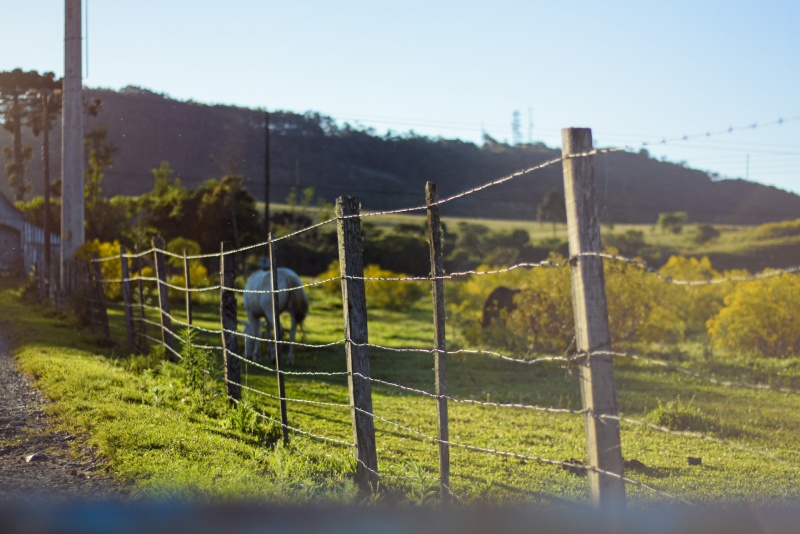
Wild dogs can be a real headache for anyone with livestock. Many of us have seen the damage they cause. Predator Proof Farm Fencing makes a big difference and keeps out foxes and feral cats too.
This guide shares simple ways to protect your animals with strong fencing, clear tips, and easy steps. Take a look to see how you can make your place safer today.
We need fencing that stands up to harsh weather and persistent predators. The right set-up keeps even the cleverest foxes, wild dogs, or feral cats from getting close to our animals.
High-tensile woven wire fencing gives us a strong barrier to protect livestock. We use two mesh sizes for extra defence. The top layer has 40-millimetre openings and the bottom has 30-millimetre gaps, keeping out even smaller animals like rabbits.
Barbed wire remains a cheaper choice but it can hurt our animals if they get too close. Welded wire panels offer strength along with good airflow and visibility, so we can keep an eye on our stock with ease.
Mesh and woven designs work well since small predators struggle to squeeze through or climb them.
Woven and welded wire fences hold up year after year, making them ideal for both large herds and backyard flocks.
After we choose tough materials and fine mesh, getting the design right is just as important for stopping predators that dig, climb, or jump. We use fences with a good height to block kangaroos and foxes from leaping over—sometimes going taller than 1.8 metres if needed.
A curved top at the upper edge makes climbing hard for cats, wild dogs, or possums.
For animals that like to dig under, we add buried skirts made of wire mesh around the base of our fence. This skirt stretches about 30 centimetres underground so even stubborn digging mammals stay out.
Costs vary greatly dependant on location; some sites like Mount Zero-Taravale faced costs up to $80,000 due to cyclonic weather and rough ground in Queensland’s north.
We always check local conditions before building since strong winds or rocky soils call for extra planning and tougher gear. Clearing pests inside fenced zones boosts success—no point fencing them in with our livestock! By keeping designs simple but smart using these steps—and learning from real projects across Australia—we protect stock without blowing budgets on repairs later down the track.
Predator-proof fencing gives us peace of mind. It keeps our livestock safe from harm and lowers the chances of losses.
We know how crucial it is to keep our livestock safe. Predator-proof fencing greatly reduces losses. Strong mesh and woven wire fences stop small predators from squeezing through. They are also tough to climb, ensuring our animals stay protected.
Electric fencing boosts security against climbing and digging threats. This extra layer of protection gives us peace of mind and keeps our livestock secure. With less risk, we can focus on farming without constant worry about losing precious animals.
It’s all about keeping them safe and sound!
To keep our fencing strong and effective, we should regularly check for damage and fix any issues right away. A little upkeep goes a long way in protecting our livestock… So, let’s stay on top of it! Want to know more about keeping our fences in shape? Keep reading!
We must check our fencing often. Regular inspections help us find problems before they get worse. Common issues include sagging wire, leaning posts, and gaps around gates. We need to tighten or re-stretch sagging wire to keep the fence strong and secure.
Any leaning posts should be re-secured or replaced quickly. This prevents collapse during bad weather or when livestock push against them. Gaps around gates can let animals escape, so fixing these is vital too.
Strong hardware will stop this from happening as well.
Broken or rusted wire needs our attention immediately. Upgrading to rust-free materials will save us trouble later on. After extreme weather events, we should inspect everything once more to make sure the fence stays safe and intact for our livestock.
Protecting our livestock with predator-proof fencing is key. Strong and smart designs keep out foxes and wild dogs. Regular maintenance helps us spot problems early. Using tech for monitoring makes fence management easier, too.
With good fences, we can ensure our animals stay safe and sound!
Predator-proof fencing keeps sheep, goats, and cattle safe from wild dogs or foxes. Strong barriers stop predators entering paddocks. Reliable fences mean fewer losses and less worry.
Heavy-duty wire mesh suits most farms. Steel posts last longer than timber ones in wet areas. Electric wires add extra security along the fence line.
A fence at least 1.5 metres tall stops most foxes and wild dogs climbing over it; some farmers go higher if needed.
Walk the boundary often, looking for holes or loose wires that could let animals through; repair damage as soon as you spot it to stay ahead of threats.
Search our marketplace